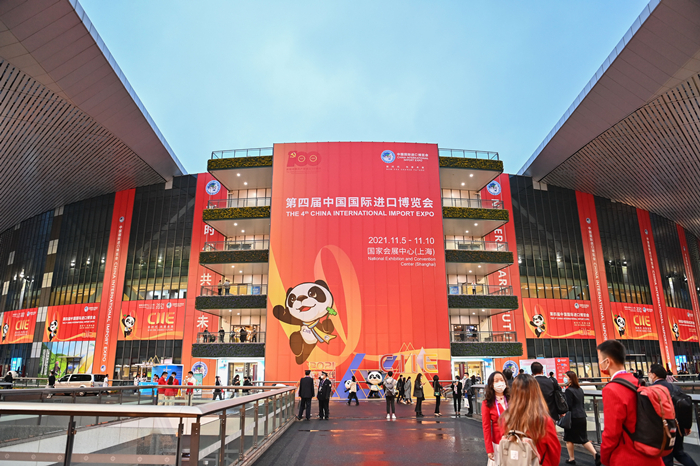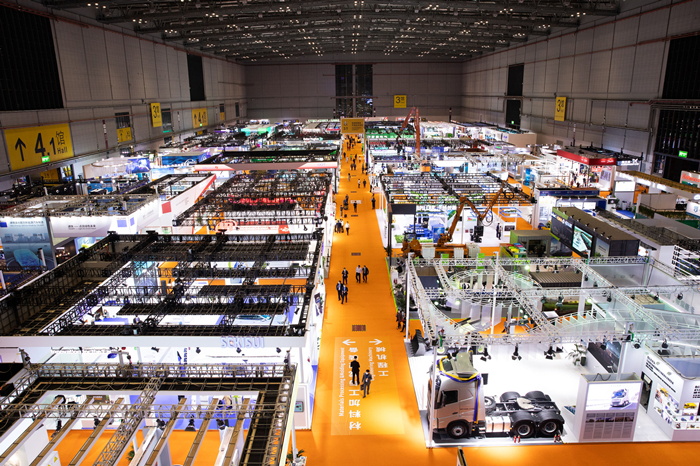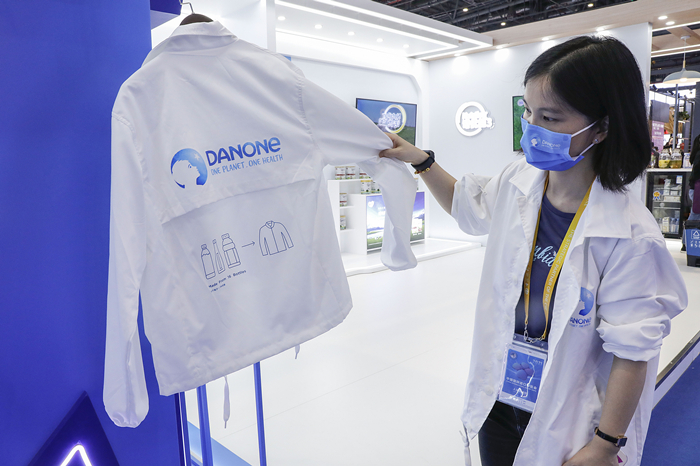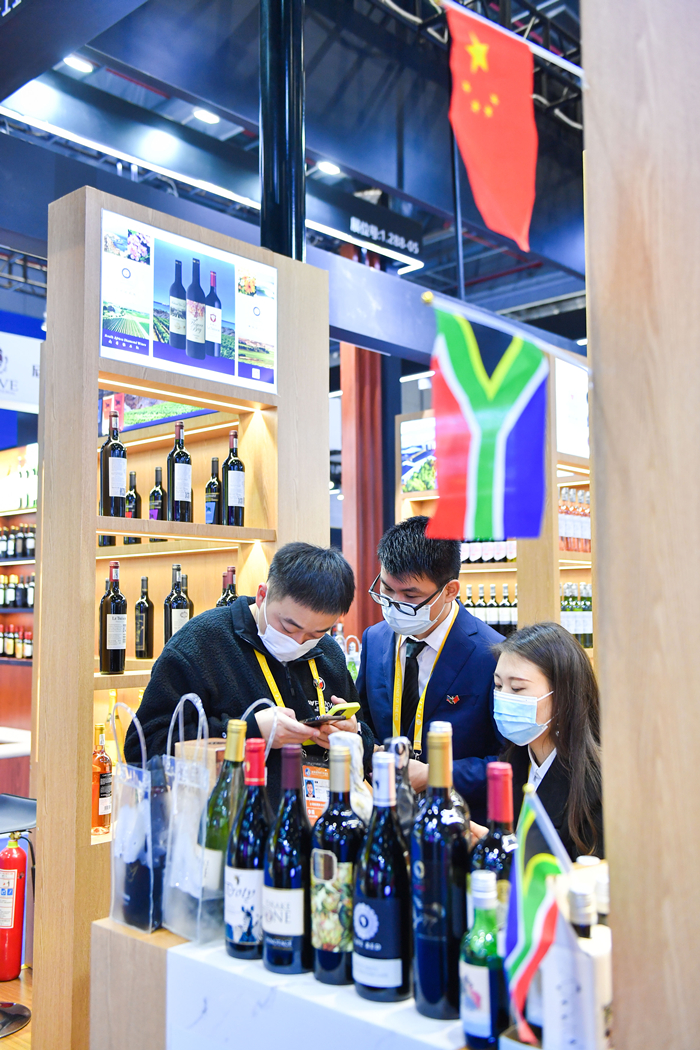|
||||||||||
| Home Nation World Business Opinion Lifestyle ChinAfrica Multimedia Columnists Documents Special Reports |
|
||||||||||
| Home Nation World Business Opinion Lifestyle ChinAfrica Multimedia Columnists Documents Special Reports |
| Current Cover Story |
| A Platform for All |
| The China International Import Expo continues to serve as a vital avenue for countries to enhance their exposure to China market |
| By Hu Fan, Li Xiaoyang & Ma Miaomiao 丨VOL. 13 DECEMBER 2021 ·2021-11-29 |

Visitors at the Fourth CIIE on November 9 (XINHUA)
Inaugurated in 2018, the CIIE is the world’s first import-themed national-level trade show. This year’s edition, in a first-ever, launched an online country exhibition. According to the CIIE Bureau, a total of 58 countries and three international organizations participated, with five, including two from Africa, making their CIIE debut.
Also for the first time, the expo established a cultural relics and art section this year, bringing masterpieces to Chinese collectors. The section also displayed derivatives of overseas intellectual properties such as the Louvre and the British Museum.
The business exhibition again covered six areas: food and agricultural products, automobiles, technology, consumer goods, healthcare and trade in services. Nearly 3,000 companies from 127 countries and regions made an appearance, covering an offline exhibition area of 366,000 square meters - expanding on the 2020 edition.
A total of 422 new products, technologies and service solutions were presented during the expo, marking a record high. The medical equipment and healthcare products category contributed the largest share, with 135 novel goods.
The expo once again saw the gathering of cutting-edge innovations from the world’s strongest companies, including 281 Fortune 500 companies and industry leaders, and specialties from less developed countries such as the Democratic Republic of the Congo and Mauritius, which were among the five first-timers.
“The CIIE is a platform for all mankind. All countries, including the least developed countries, can have their gain in the open market that this platform connects them to,” Sun said.

An exhibition hall for equipment at the Fourth CIIE on November 5 (XINHUA)
Cutting-edge items
For many global enterprises, the CIIE provides a platform to exhibit their latest innovations. The highlighted products included a solution that can help reduce the production costs of drugs and vaccines from 3M, a U.S.-based multi-manufacturer and a fourth-time exhibitor, and devices from U.S.-based Boston Scientific that offer remote monitoring for arrhythmia sufferers.
Mind-blowing items were also brought by intelligent technology suppliers, who have sensed rising opportunities in the market as China seeks industrial restructuring. Japan-based Nachi-Fujikoshi, also a four-time participant in the expo, exhibited industrial robots for welding and construction.
The company was among the first multinational companies to sign up to take part in the first CIIE in 2018, and went on to establish a subsidiary in Shanghai in 2019. According to Liu Xiaobing, Deputy Director General of the company’s Shanghai branch, its businesses resumed swiftly in 2020 after weathering epidemic-induced afflictions and even reached a record high in May last year as the epidemic actually resulted in the increase of demand for unmanned technologies and facilities. He said that with China’s shift from a global factory to a manufacturing power, consumer demand is bound to grow in the post-epidemic era.
Swiss-based industrial company ABB is also optimistic about further developing its robot business in China, its largest robotics market. The company exhibited diverse products and solutions, including one of its star products called YuMi, a collaborative dual-arm robot.
Lars Eckerlein, General Manager of ABB (China), said that the business potential in China is huge given that it is also subject to labor shortages caused by rapid urbanization and climate change, which can be addressed via industrial upgrading and the expansion of robotics and machine automation technologies. Moreover, robot density, meaning the number of robots per 10,000 workers, has been snowballing in China over the past years, and has not yet reached similar levels in other countries.
According to him, ABB is constructing a new production facility worth $150 million in Shanghai, which will open in the first half of 2022. It will be a factory where robots are used to assemble new robots for advanced and automated production. “We are optimistic about the development in the Chinese market and will therefore keep investing in it,” Eckerlein added.

A jacket made from recycled plastic bottles is on display at the booth of French food group Danone at the Fourth CIIE on November 7 (XINHUA)
Focus on eco
While expanding business and increasing investment in the Chinese market, multinationals are adjusting their development roadmaps to echo China’s goals for achieving carbon neutrality before 2060.
ABB presented a system to screen greenhouse gases occurring in the air across different environmental settings. It also showcased a platform for the monitoring and adjusting of overall power use in buildings, through which users can save energy when demand is low - and even sell the extra electricity to those in need. The platform has been applied in ABB itself and several of its business partners.
Germany-based chemical company Covestro debuted at the expo this year with one of its key technologies, namely Triturn CO2 technology, which enables carbon dioxide to be reused as an alternative raw material in polyol production to replace up to 20 percent of fossil feedstock. Polyol can be used to create mattresses, fabric materials and decorative products for vehicles.
Other interesting technologies included carbon capture technologies from U.S.-based industrial gas supplier Air Products, heat-free printing technology from Japan-based printer company Epson, energy-saving auto parts for electric vehicles from German engineering and technology company Bosch, and jackets made from recycled plastic bottles from French food group Danone.
As the Chinese Government works on cutting carbon emissions and enhancing public awareness about the topic, Chinese consumers have started to focus much more on environmentally friendly and organic products, Bruno Chevot, President of Danone Greater China & Oceania, told a CIIE forum on November 5.
For enterprises, the key is not only to reduce carbon emissions in production, but also to enhance supply chains to gain access to green raw materials and achieve low-carbon production from the onset, he said.
Some companies have already been doing it. P&G announced its Net-Zero 2040 goals at the event, meaning to “achieve zero carbon emissions from operations all the way to the time when products reach the hands of retailers.”
As part of this program, it further unveiled its e-commerce packaging made from mono and recyclable materials – 100-percent waterproof to prevent parcel damage. Compared with the current corrugated parcel packaging, this upgraded version uses 40 percent fewer materials.
Microsoft is committed to being carbon neutral by 2030 and remove from the environment all carbon that the firm has emitted since its inception in 1975 by 2050.
During the expo, the company made several announcements along with SGS, a Swiss testing, inspection and certification company, to build an S-Carbon management platform to manage enterprises’ carbon emission targets and help users enhance their international competitiveness and green financing abilities under the carbon neutrality goal.

A visitor negotiates with exhibitors at the booth of South Africa at the Fourth CIIE on November 9 (WEI YAO)
African participation
For African countries, the CIIE provided another great opportunity to showcase their products and strike deals with Chinese buyers after the China-Africa Economic and Trade Expo, which concluded in Changsha, Hunan Province, on September 29. Although the pandemic made it difficult for many African countries and companies to join the exhibitions physically, the online country exhibitions provided them a window to show their products and attractions.
Mauritius, which joined the expo as a country for the first time, was among the 58 countries with online exhibitions. With pictures and videos, the country presented their specialties such as jewelry, tea, rum and sugar. As a famous tourist destination in the Indian Ocean, it also displayed its charm in a bid to attract more tourists to the country.
According to Hu Ming, Commercial Counselor at the Chinese Embassy to Mauritius, the country has been actively participating in the expo in recent years. Though it didn’t organize companies to take part in the offline exhibitions of this year’s expo due to the pandemic, many of its companies attended the second and third editions of the expo, exhibiting products like sugar, rum and beer, which are now entering the Chinese market.
For Rwanda, it was the fourth time the east African country exhibited products on-site at the expo. This year, they had an exhibition area four times the size in 2018 to display its various products ranging from coffee and tea to handmade baskets. The one product that got the most attention, however, was Rwandan dry chili, which just had its first shipment delivered to China.
At the expo, the country was looking to more than just selling the products. “We encourage Chinese companies to go to Rwanda and set joint ventures with local growers to expand chili pepper yield,” said Abikunda Samuel, Commercial Counselor at the Embassy of Rwanda in China, in an interview with China Central Television, adding that the country has one of the best businesses environments in Africa.
Rwanda also participated in the online exhibitions. In a livestreaming event it organized, thousands of bags of coffee were sold out in seconds.
Samuel said China’s efforts in opening up wider has allowed more goods and products from Rwanda and other countries to enter the huge Chinese market with 1.4 billion people. “I believe the prospects for our cooperation are promising,” he said.
As Wang Shouwen, Vice Minister of Commerce, told an expo forum on November 5, China has a large and growing market with increasingly diversified demand.
“China has been raising its imports in recent years by lowering tariffs, developing pilot free trade zones, boosting cross-border e-commerce and hosting trade events such as the CIIE. China’s domestic demand has become a strong driving force of its own economy and also shored up global economic growth,” Wang said.
Comments to hufan@chinafrica.cn
| About Us | Contact Us | Advertise with Us | Subscribe |
| Copyright Beijing Review All rights reserved 京ICP备08005356号-5 京公网安备110102005860号 |